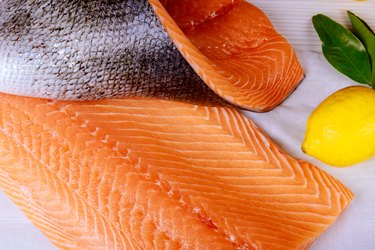
Do you have fresh salmon that you can't eat right away? Freezing the fish extends its life and keeps your freezer stocked with the nutrient-dense protein. You want to take care in packing your fresh salmon for the freezer. Keeping the fish moist and away from air makes it last longer, taste better and maintain its texture.
Start With Fresh Salmon
Video of the Day
When it's fresh, salmon usually lasts about two days in the refrigerator. If you know you won't eat the salmon in two days, freeze it right away to lock in as much freshness as possible. If the fish is already borderline, freezing it won't make it any fresher, and you'll want to eat it right away after thawing.
Video of the Day
You can tell your salmon is fresh if it has firm, shiny flesh and not dull or mushy flesh. It should spring back when you touch it. Check for a mild, fresh scent without a strong fishy or ammonia smell. On a whole salmon, look for clear eyes with just a little bulge, not cloudy eyes. Also look for discoloration or darkening anywhere on the salmon, which can mean that it's old.
Prepare the Salmon
For a whole salmon, clean the meat before freezing salmon. Rinse it to remove any blood and other debris. Cutting the whole salmon into smaller pieces makes it easier to freeze. The smaller pieces are also easier to thaw, allowing you to only thaw and cook what you need since it's not a good idea to thaw and refreeze salmon.
If the salmon is already cut into fillets, it's still a good idea to rinse the fish first. You can season the salmon or add lemon slices before freezing if you want.
You can also freeze the pieces individually before wrapping. This helps them freeze quickly. Place them on a baking sheet lined with wax paper and put the pan in the freezer. Once they're frozen, wrap them for storage.
Wrap the Fish
Your goal with fish freezing methods is to keep the fish as moist as possible while keeping air from reaching it. This preserves the salmon's quality as best as possible in the freezer. Air that gets inside the wrapping can dry out the salmon or cause freezer burn.
Start with a tight layer of plastic wrap, keeping as much air out of the packaging as possible. Wrap a layer of aluminum foil around the fish, again making it tight without air. Make sure the foil seals well around the fish to lock out the air.
Place the wrapped salmon inside a freezer bag for extra protection. Squeeze excess air out of the bag before sealing it. Label the outermost packaging with the date to track its freshness.
Choose the Best Spot for Freezing Salmon
Even though you adjust your freezer controls to a certain setting, the compartment doesn't have a consistent temperature throughout. The coldest spots tend to be on the bottom and near the back wall of the freezer. Spots near the door tend to be warmer because you let in hot air every time you open it. Put your salmon in the coldest areas when freezing salmon to keep it as cold and frozen as possible.
Keep Salmon Frozen
It's best to keep the salmon in the freezer until you're ready to serve it. If you thaw the fish and refreeze it, the process can affect both the texture and flavor. As soon as the salmon starts to thaw, the rising temperature can increase the growth of bacteria, which can cause foodborne illness. It's best to keep the fish frozen solid until you're sure you want to cook it.